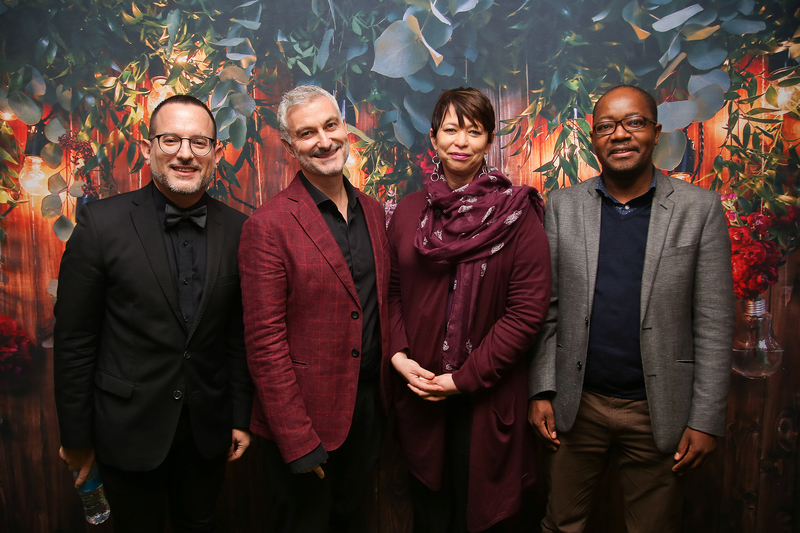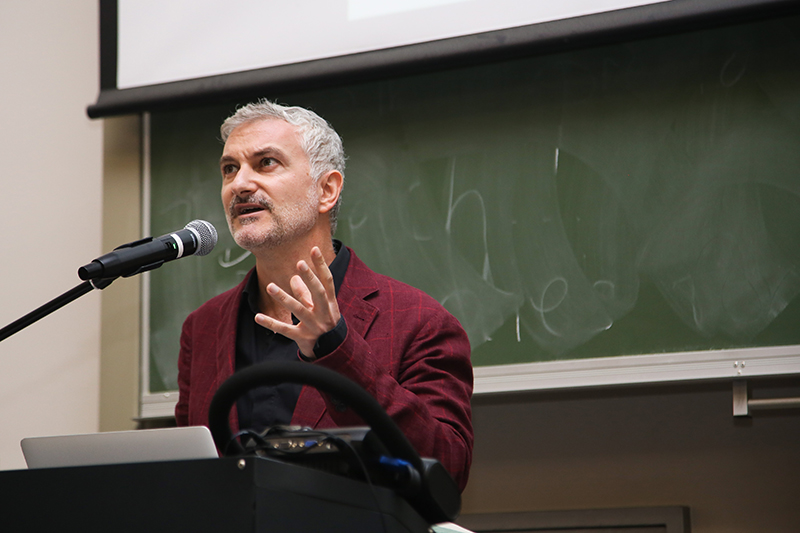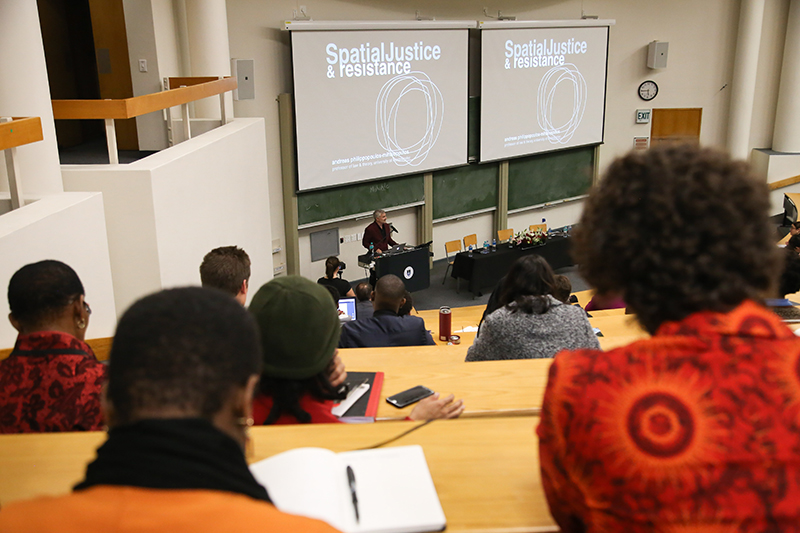Redressing apartheid’s spatial injustices
17 July 2019 | Story Carla Bernardo. Photos Je’nine May. Read time 8 min.
Cape Town’s combination of geography and city planning perpetuates the effects of apartheid spatial planning. The mountains and oceans become natural barriers to movement and access, the planning around which creates a clear centre and periphery, segregating residents.
That is what struck Professor Andreas Philippopoulos-Mihalopoulos, he said, as he arrived in the city to deliver the British Academy Newton Advanced Fellowship Lecture in Spatial Justice, titled “Spatial Justice and Resistance”.
“It strikes me that this city – geographically, geologically, geopolitically – is the thing that I am trying to think about,” he said, referring to his consideration of the role of law in the perpetuation and the undoing of the spatial legacy of apartheid in South Africa.
Philippopoulos-Mihalopoulos, an internationally-recognised expert on spatial justice, is the director of the Westminster Law and Theory Lab and professor of law and theory at the University of Westminster in London. He delivered his lecture at the University of Cape Town (UCT) on Monday, 15 July.
The Newton Advanced Fellowship Lecture is part of a three-year collaborative research project titled Spatial Justice in the Postcolony: Legacies of the Nomos of Apartheid.
It was among a series of events, held over 12 days, to mark the end of Professor Jaco Barnard-Naudéʼs term as the British Academyʼs Newton Advanced Fellow in the School of Law at Westminster University, which concludes 30 March 2020. Barnard-Naudé is a member of the Department of Private Law at UCT and is co-director of the Centre for Rhetoric Studies in the law faculty.
Lawscape
Philippopoulos-Mihalopoulos began by defining the first concept under discussion, the lawscape.
“Simply put, there is no law without space … there is no space that is not regulated by some sort of law.”
Cape Town and its geography, geology and geopolitics is a lawscape. So too are the ways in which people have been segregated, how access is allowed or compromised in certain ways, and how parts of the city “come alive” while others do not.
“We are constantly being, producing, inhabiting, being regulated by a lawscape,” he explained.

Also part of lawscape is how people behave, depending on their location. Philippopoulos-Mihalopoulos offered the example of people behaving differently in supermarkets compared to in airports.
“As soon as we enter specific lawscapes, there are specific codes that we have to follow,” he said.
“The concept of the lawscape means that the body itself is conditioned by the space around it.”
Atmosphere
The second concept discussed was atmosphere.
“Atmosphere is a lovely, cosy way of excluding. Whoever isn’t part of us becomes invisibilised, becomes outside,” he said, explaining that atmosphere relies on things that are to a large extent invisible, or not considered, such as air.
“The higher up you go, the air is nicer, you can breathe … and obviously, that is why you have specific spatial arrangements in terms of where the air is good and where the air is bad. The urban poor are the ones who get the worst air and they suffer so much more in terms of diseases.”
Atmosphere, he added, is produced through three conditions. The first – essentially fake – distinction is between the inside and the outside.
“It’s a little bit like gated communities … you’re inside, the outside is not something that concerns us but there is a naturalised division between inside and outside.”
“It’s a little bit like gated communities … you’re inside, the outside is not something that concerns us.”
This distinction leads to the second condition: a kind of incubation “to bring the outside in”.
“How? As a threat? As otherness? As something we don’t want to be a part of, as something to remind us that we are better off in, in our little tennis club, in our small boutique … grocery store [that] doesn’t have everything but it is safe?”
There is a vested interest in maintaining this boundary.
The third condition is the impression of synthesis. This, he said, is the impression that within the atmosphere, everything that’s needed is there; the outside is not needed.
“We demonise the outside in such perfect detail that it becomes a part of our own atmosphere. We don’t want to change it.”
Some people within the atmosphere will venture outside and have their ideas changed or challenged, but most will generally return to that with which they’re comfortable.
Spatial justice
The third and final concept discussed at the lecture was spatial justice.
“ … it’s imperative [for it] to be thought of both as a legal tool, as a legal concept, as well as a spatial geographical concept,” said Philippopoulos-Mihalopoulos.
It is “the desire of two or more bodies to occupy the same space, at the same time”.
Spatial justice is a good thing, but it needs repetition to avoid coagulation or the risk of becoming a co-opted “tool of the various regimes”.
Philippopoulos-Mihalopoulos is interested in withdrawal as an act of resistance.
“I want to clarify that withdrawal isn’t a passive moment of ceding ethical priority to the other. It is a way of fighting for one’s ground by precisely changing the ground,” he explained.
Withdrawal is a radical move whereby you allow a regime to collapse while you are withdrawing. What follows is that spatial justice emerges when a “withdrawing body crosses into a differently oriented space in which the register of conflict might change”.
“I want to clarify that withdrawal isn’t a passive moment of ceding ethical priority to the other. It is a way of fighting for one’s ground by precisely changing the ground.”

He said he found it impressive that South Africa is one of the few countries that refers to spatial justice as a principle in a major Act, namely the Spatial Planning and Land Use Management Act 16 of 2013.
In the South African context, he said, wanting to redress past spatial imbalances is “obviously understandable”. His view, however, differs.
“In the context of spatial justice – the way I try to define it – [it] is a trap. And this is why having spatial justice that tries to redress is violence.”
Organising according to a “haunting past”, which paralyses and is horrible for both sides, does not result in “great progress”.
“Spatial justice tries to think of the present … It talks about, essentially, not forgetting but perhaps finding … somewhere, a radical way of forgiving,” he said, emphasising the need for dialogue.
Philippopoulos-Mihalopoulos admits that there is no easy answer or solution.
“Spatial justice is never the final thing; it is always a new way of discussing.”
He concluded by saying that spaces are “haunted by our desire to belong and to exclude”, and these desires are, in fact, one. South Africa should reframe its spatial justice discussion to steer away from access to resources and rather to embrace the approach that sees “humans as a collectivity with what is called resources”.
 This work is licensed under a Creative Commons Attribution-NoDerivatives 4.0 International License.
This work is licensed under a Creative Commons Attribution-NoDerivatives 4.0 International License.
Please view the republishing articles page for more information.










